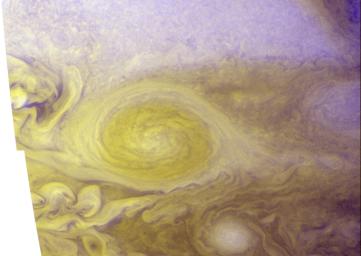
|
Best Color Image of Jupiter’s Little Red Spot
- Click the image above for a larger view
- Full-Res JPEG (962 x 682) (80.4 kB)
- Full-Res TIFF (962 x 682) (2.0 MB)
Caption:
This amazing color portrait of Jupiter's "Little Red Spot" (LRS) combines high-resolution images from the New Horizons Long Range Reconnaissance Imager (LORRI), taken at 03:12 UT on February 27, 2007, with color images taken nearly simultaneously by the Wide Field Planetary Camera 2 (WFPC2) on the Hubble Space Telescope. The LORRI images provide details as fine as 9 miles across (15 kilometers), which is approximately 10 times better than Hubble can provide on its own. The improved resolution is possible because New Horizons was only 1.9 million miles (3 million kilometers) away from Jupiter when LORRI snapped its pictures, while Hubble was more than 500 million miles (800 million kilometers) away from the Gas Giant planet.
The Little Red Spot is the second largest storm on Jupiter, roughly 70% the size of the Earth, and it started turning red in late-2005. The clouds in the Little Red Spot rotate counterclockwise, or in the anticyclonic direction, because it is a high-pressure region. In that sense, the Little Red Spot is the opposite of a hurricane on Earth, which is a low-pressure region - and, of course, the Little Red Spot is far larger than any hurricane on Earth.
Scientists don't know exactly how or why the Little Red Spot turned red, though they speculate that the change could stem from a surge of exotic compounds from deep within Jupiter, caused by an intensification of the storm system. In particular, sulfur-bearing cloud droplets might have been propelled about 50 kilometers into the upper level of ammonia clouds, where brighter sunlight bathing the cloud tops released the red-hued sulfur embedded in the droplets, causing the storm to turn red. A similar mechanism has been proposed for the Little Red Spot's "older brother," the Great Red Spot, a massive energetic storm system that has persisted for over a century.
New Horizons is providing an opportunity to examine an "infant" red storm system in detail, which may help scientists understand better how these giant weather patterns form and evolve.
Cataloging Keywords:
| Name | Value | Additional Values |
|---|---|---|
| Target | Jupiter | |
| System | Jupiter | |
| Target Type | Planet | |
| Mission | Hubble Space Telescope (HST) | New Horizons |
| Instrument Host | Hubble Space Telescope | New Horizons |
| Host Type | Space Telescope | Flyby Spacecraft |
| Instrument | Long Range Reconnaissance Imager (LORRI) | Wide Field/Planetary Camera 2 (WFPC2) |
| Detector | ||
| Extra Keywords | Ammonia, Atmosphere, Color, Infrared, Rotation, Storm, Visual | |
| Acquisition Date | ||
| Release Date | 2007-05-01 | |
| Date in Caption | 2007-02-27 | |
| Image Credit | NASA/Johns Hopkins University Applied Physics Laboratory/Southwest Research Institute | |
| Source | photojournal.jpl.nasa.gov/catalog/PIA09341 | |
| Identifier | PIA09341 | |
